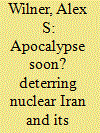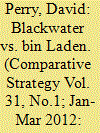|
|
|
Sort Order |
|
|
|
Items / Page
|
|
|
|
|
|
|
| Srl | Item |
| 1 |
ID:
110874


|
|
|
|
|
| Publication |
2012.
|
| Summary/Abstract |
The arguments presented here are based on a future scenario in which Iran has succeeded in developing nuclear weapons. Employing the logic and theory of deterrence, the article suggests ways in which the United States and its allies might counter, contain, and coerce nuclear Iran's sponsorship of terrorism and nonstate militant groups. Four strategic concerns are explored in particular: nuclear Iran may blackmail rival and neighboring states; shield an especially assertive foreign policy; protect its nonstate proxies and protégés; and facilitate nuclear terrorism. Deterrence theory is applied to each scenario.
|
|
|
|
|
|
|
|
|
|
|
|
|
|
|
|
| 2 |
ID:
110876


|
|
|
|
|
| Publication |
2012.
|
| Summary/Abstract |
Reacting to Iraq's invasion and annexation of Kuwait, two European states, the United Kingdom and France, contributed large forces and participated in land, air, and sea operations. The contributions of these states varied considerably in their composition and role. The United Kingdom deployed as many forces (45,000 personnel) as the country could manage, while France sent a significant force (15,000) that fell short of its potential. Once in Arabia, the British played a major role in coalition planning, while the French remained operationally aloof. Finally, when it came to launch offensive operations, British forces were central to the coalition's riskiest endeavors, such as special forces raids and preparing a fake amphibious invasion, while French forces played a credible, but less dangerous role. This article tests the ability of realism and historic institutionalism to explain these different responses to the 1990-91 Gulf Crisis. Although realism appears a priori to possess a high degree of explanatory power, a detailed process tracing analysis reveals that historical institutionalism can better account for the different outcomes observed.
|
|
|
|
|
|
|
|
|
|
|
|
|
|
|
|
| 3 |
ID:
110875


|
|
|
|
|
| Publication |
2012.
|
| Summary/Abstract |
This article examines the United States government's use of private military and security companies (PMSCs) in support of its post-9/11 counterterrorism efforts. To date, existing studies on defense privatization have concentrated largely on the American military's use of contractors in Iraq. Here, the focus is broadened to examine PMSC support for military operations in Afghanistan, covert operations in Afghanistan and Pakistan, homeland security, and the intelligence community. Existing understandings of both strategic studies and American counterterrorism are partial, as they ignore the vital, and increasing, role played by private contractors. Overall, the current conduct of American counterterrorism relies heavily on the private sector and this reliance is problematic.
|
|
|
|
|
|
|
|
|
|
|
|
|
|
|
|
| 4 |
ID:
110877


|
|
|
|
|
| Publication |
2012.
|
| Summary/Abstract |
The Nuclear Non-Proliferation Treaty is considered the model for how to address the complex problem of proliferation. This article analyzes the NPT's impact on the decision to peacefully give up nuclear weapons programs in four states-South Korea, Argentina, Brazil, and Libya. It concludes that while the nuclear decision-making calculus is complicated, because of the centrality of security concerns in nuclear decision-making, the NPT as currently structured appears not to have had a meaningful impact. This article accordingly suggests that nonproliferation efforts should focus on working directly with problem states to alter their calculations about the utility of nuclear weapons.
|
|
|
|
|
|
|
|
|
|
|
|
|
|
|
|
| 5 |
ID:
110873


|
|
|
|
|
| Publication |
2012.
|
| Summary/Abstract |
Analyses of U.S. strategic force requirements frequently are based on assertions about the requirements for deterrence. A politically attractive position is that a relatively small number of nuclear weapons reliably meets U.S. strategic nuclear requirements. This position, however, is flawed for two reasons: first, the number/types of nuclear weapons required for deterrence cannot be identified with precision because requirements shift dramatically across time and circumstances. Second, strategic forces also are intended to assure allies and limit damage, and these goals entail separate requirements that must be included in any serious calculation of U.S. strategic force requirements.
|
|
|
|
|
|
|
|
|
|
|
|
|
|
|
|
|
|
|
|
|